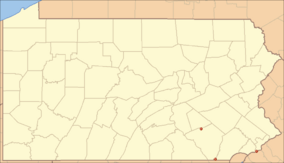William Penn State Forest facts for kids
Quick facts for kids William Penn State Forest |
|
|---|---|

Antietam Creek in the Ruth Zimmerman Natural Area of William Penn State Forest in Berks County.
|
|

Location of the three tracts of William Penn State Forest in Pennsylvania
|
|
| Location | Pennsylvania, United States |
| Area | 901 acres (365 ha) |
| Elevation | 239 ft (73 m) |
| Established | January, 1935 |
| Named for | William Penn |
| Governing body | Pennsylvania Department of Conservation and Natural Resources |
| Website | William Penn State Forest |
The William Penn State Forest is a special forest area in Pennsylvania, United States. It's managed by the Pennsylvania Bureau of Forestry to protect nature and offer outdoor fun. This forest is named after William Penn, who was the founder of Pennsylvania.
It covers about 901 acres, which is like 680 football fields! But it's not all in one big piece. Instead, it's spread out in ten smaller areas across different counties. These counties include Lancaster, Delaware, Chester, Bucks, and Berks. The main office for the forest is in Elverson, which is in Chester County.
Contents
How the Forest Got Its Name
This forest wasn't always called William Penn State Forest. It used to be known as "Valley Forge State Forest." This name came from Valley Forge, a famous camp during the American Revolutionary War.
For a long time, the state forest and Valley Forge State Park shared a name and even headquarters. But in 1976, Valley Forge State Park became a national park, managed by the National Park Service. Even after this, the state forest kept the "Valley Forge" name for 31 more years.
In 2007, the state decided to change the forest's name to avoid confusion with the national park. They chose to honor William Penn, who was one of Pennsylvania's first supporters of protecting nature. This new name helps everyone know the difference between the state forest and the national park.
A Look Back: The Forest's History
The William Penn State Forest, like many state forests in Pennsylvania, was created because people realized that too many trees were being cut down. In the late 1800s, lumber and iron companies cut down huge areas of old-growth forest (forests that had never been cut). They often left behind a mess of dry branches and stumps.
This led to many wildfires, often started by sparks from steam locomotives. These fires made it hard for new trees to grow back. People like Dr. Joseph Rothrock, a conservationist, worried that Pennsylvania's forests would disappear forever.
They pushed for a new way to manage forests. In 1895, Dr. Rothrock became the first commissioner of the Pennsylvania Department of Forests and Waters. This department later became today's Pennsylvania Department of Conservation and Natural Resources. In 1897, a law was passed that allowed the state to buy land to create "forest reservations." This was the start of Pennsylvania's State Forest system.
First Land Purchases
The very first piece of land for what is now William Penn State Forest was bought in 1935. It was a 10-acre plot in Lancaster County. This land included a fire tower that had been built in 1923.
The next big land purchases happened much later, in 1982.
- In November 1982, Little Tinicum Island in the Delaware River was bought. This island is special because it has unique plants and animals.
- In December 1982, the Goat Hill Serpentine Barrens were purchased. This area covers 602 acres and is also home to very rare and special plants and habitats. The Nature Conservancy helped with the money to buy this land.
These purchases helped create the unique and spread-out William Penn State Forest we know today.
Nearby Nature Spots
Even though there are no state parks inside William Penn State Forest, there are many other great state parks nearby in the same region. These parks offer more chances to explore nature and enjoy outdoor activities.
Some of the state parks in the area include:
- Delaware Canal State Park
- Evansburg State Park
- Fort Washington State Park
- French Creek State Park
- Marsh Creek State Park
- Neshaminy State Park
- Nockamixon State Park
- Nolde Forest Environmental Education Center
- Norristown Farm State Park
- Ridley Creek State Park
- Benjamin Rush State Park
- Ralph Stover State Park
- Susquehannock State Park
- Tyler State Park
- White Clay Creek Preserve

